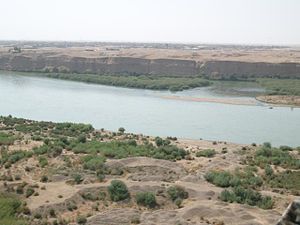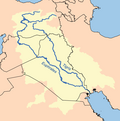Tigris: Difference between revisions
m Reverted edits by 118.210.0.81 (talk) to last revision by ClueBot NG (HG) |
|||
| Line 100: | Line 100: | ||
After the war, river trade declined in importance during the 20th century as the Basra-Baghdad-Mosul [[railway]], an unfinished portion of the [[Baghdad Railway]], was completed and roads took over much of the freight traffic. |
After the war, river trade declined in importance during the 20th century as the Basra-Baghdad-Mosul [[railway]], an unfinished portion of the [[Baghdad Railway]], was completed and roads took over much of the freight traffic. |
||
I love willys |
|||
== Etymology == |
== Etymology == |
||
Revision as of 03:21, 26 February 2014
The Tigris River /ˈtaɪɡrɪs/ is the eastern member of the two great rivers that define Mesopotamia, the other being the Euphrates. The river flows south from the mountains of southeastern Turkey through Iraq.
Geography
The Tigris is 1,850 km long, rising in the Taurus Mountains of eastern Turkey about 25 km southeast of the city of Elazig and about 30 km from the headwaters of the Euphrates. The river then flows for 400 km through Turkish territory before becoming the border between Syria and Turkey. This stretch of 44 km is the only part of the river that is located in Syria.[1]
Close to it's confluence with the Euphrates, the Tigris splits into several channels. First, the artificial Shatt al-Hayy branches off, to join the Euphrates near Nasiriyah. Second, the Shatt al-Muminah and Majar-al-Kabir branches off to feed the Central Marshes. Further downstream, two other distributary channels branches off (the Al-Musharrah and Al-Kahla), which feeds the Hawizeh Marshes. The main channel continues southwards and is joined by the Al-Kassarah, which drains the Hawizeh Marshes. Finally, the Tigris joins the Euphrates near al-Qurnah to form the Shatt-al-Arab. According to Pliny and other ancient historians, the Euphrates originally had its outlet into the sea separate from that of the Tigris.[2]
Baghdad, the capital of Iraq, stands on the banks of the Tigris. The port city of Basra straddles the Shatt al-Arab. In ancient times, many of the great cities of Mesopotamia stood on or near the Tigris, drawing water from it to irrigate the civilization of the Sumerians. Notable Tigris-side cities included Nineveh, Ctesiphon, and Seleucia, while the city of Lagash was irrigated by the Tigris via a canal dug around 2400 B.C.
The Tigris has long been an important transport route in a largely desert country. Shallow-draft vessels can go as far as Baghdad, but rafts are needed for transport upstream to Mosul.
General Francis Rawdon Chesney hauled two steamers overland through Syria in 1836 to explore the possibility of an overland and river route to India. One steamer, the Tigris, was wrecked in a storm which sank and killed twenty. Chesney proved the river navigable to powered craft. Later, the Euphrates and Tigris Steam Navigation Company was established in 1861 by the Lynch Brothers trading company. They had 2 steamers in service. By 1908 ten steamers were on the river. Tourists boarded steam yachts to venture inland as this was the first age of archaeological tourism, and the sites of Ur and Ctesiphon became popular to European travelers.
In the First World War during the British conquest of Ottoman Mesopotamia, Indian and Thames River paddlers were used to supply General Townsend's Army. See Siege of Kut and the Fall of Baghdad (1917).[3] The Tigris Flotilla included vessels Clio, Espiegle, Lawrence, Odin, armed tug Comet, armed launches Lewis Pelly, Miner, Shaitan, Sumana, and stern wheelers Muzaffari/Mozaffir. These were joined by Royal Navy Fly-class gunboats Butterfly, Cranefly, Dragonfly, Mayfly, Sawfly, Snakefly, and Mantis, Moth, and Tarantula.
After the war, river trade declined in importance during the 20th century as the Basra-Baghdad-Mosul railway, an unfinished portion of the Baghdad Railway, was completed and roads took over much of the freight traffic. I love willys
Etymology
The Ancient Greek form Tigris (Τίγρις, Τίγρης) was borrowed from Old Persian Tigrā, itself from Elamite ti-ig-ra, itself from Sumerian idigna.
The original Sumerian Idigna or Idigina was probably from *id (i)gina "running water",[4] which can be interpreted as "the swift river", contrasted to its neighbor, the Euphrates, whose leisurely pace caused it to deposit more silt and build up a higher bed than the Tigris. The Sumerian form was borrowed into Akkadian as Idiqlat, and from there into the other Semitic languages (cf. Hebrew Ḥîddeqel, Syriac Deqlaṯ, Arabic Dijla).
Another name for the Tigris used in Middle Persian was Arvand Rud, literally "swift river". Today, however, Arvand Rud (New Persian: اروند رود) refers to the confluence of the Euphrates and Tigris rivers (known in Arabic as the Shatt al-Arab). In Kurdish, it is also known as Ava Mezin, "the Great Water".
The name of the Tigris in languages that have been important in the region:

| Language | Name for Tigris |
|---|---|
| Akkadian | Idiqlat |
| Arabic | دجلة, Dijla; حداقل, Ḥudaqil |
| Aramaic | ܕܝܓܠܐܬ, Diglath |
| Armenian | [Տիգրիս] Error: {{Lang}}: unrecognized language code: arm (help), [Tigris] Error: {{Transliteration}}: unrecognized language / script code: arm (help), [Դգլաթ] Error: {{Lang}}: unrecognized language code: arm (help), [Dglatʿ] Error: {{Transliteration}}: unrecognized language / script code: arm (help) |
| Greek | ἡ Τίγρης, -ητος, hē Tígrēs, -ētos;
ἡ, ὁ Τίγρις, -ιδος, hē, ho Tígris, -idos |
| Hebrew | חידקל, Ḥîddeqel biblical Hiddekel[5] |
| Hurrian | [Aranzah] Error: {{Transliteration}}: unrecognized transliteration standard: (help)[6] |
| Kurdish | Dîcle, Dîjla دیجلە |
| Persian | Old Persian: 𐎫𐎡𐎥𐎼𐎠 Tigrā; Middle Persian: Tigr; Modern Persian:دجله Dejle |
| Sumerian | Idigna/Idigina |
| Syriac | ܕܹܩܠܵܬ Deqlaṯ |
| Turkish | Dicle |

Management and water quality

The Tigris is heavily dammed in Iraq and Turkey to provide water for irrigating the arid and semi-desert regions bordering the river valley. Damming has also been important for averting floods in Iraq, to which the Tigris has historically been notoriously prone following April melting of snow in the Turkish mountains.
Recent Turkish damming of the river has been the subject of some controversy, for both its environmental effects within Turkey and its potential to reduce the flow of water downstream. Mosul Dam is the largest dam in Iraq.
Religion and mythology
The Tigris appears twice in the Bible. In the Book of Genesis, the Tigris is the third of the four rivers branching off the river issuing out of the Garden of Eden.[7] Daniel received one of his visions "when I was by that great river the Tigris".[8]
In Sumerian mythology, the Tigris was created by the god Enki, who filled the river with flowing water.[9]
In Hittite and Hurrian mythology, Aranzah (or Aranzahas in the Hittite nominative form) is the Hurrian name of the Tigris River, which was divinized. He was the son of Kumarbi and the brother of Teshub and Tašmišu, one of the three gods spat out of Kumarbi's mouth onto Mount Kanzuras. Later he colluded with Anu and the Teshub to destroy Kumarbi (The Kumarbi Cycle).
See also
- Assyria
- Cradle of civilization
- Euphrates
- Ilisu Dam Campaign campaign against a planned dam on Tigris in Turkey
- List of places in Iraq
- Mesopotamia
Notes
- ^ Cite error: The named reference
Isaevwas invoked but never defined (see the help page). - ^ Pliny: Natural History, VI, XXVI, 128-131
- ^ http://www.naval-history.net/WW1Battle1408Mesopotamia.htm
- ^ F. Delitzsch, Sumerisches Glossar, Leipzig (1914), IV, 6, 21.
- ^ Genesis 2:14
- ^ E. Laroche, Glossaire de la langue Hourrite, Paris (1980), p. 55.
- ^ Genesis 2:14
- ^ Daniel 10:4
- ^ Jeremy A. Black, The Literature of Ancient Sumer, Oxford University Press 2004, ISBN 0-19-926311-6 p. 220-221
External links
- Livius.org: Tigris
- Hausleiter, A., M. Roaf, St J. Simpson, R. Wenke, P. Flensted Jensen, R. Talbert, T. Elliott, S. Gillies. "Places: 912964 (Tigris/Diglitus fl.)". Pleiades. Retrieved March 9, 2012.
{{cite web}}: CS1 maint: multiple names: authors list (link) - Managing the Tigris and Euphrates Watershed
- Bibliography on Water Resources and International Law Peace Palace Library
- [1]


